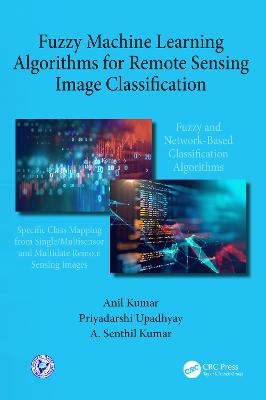
Fuzzy Machine Learning Algorithms for Remote Sensing Image Classification
CRC Press (Verlag)
978-0-367-35571-5 (ISBN)
This book covers the state-of-art image classification methods for discrimination of earth objects from remote sensing satellite data with an emphasis on fuzzy machine learning and deep learning algorithms. Both types of algorithms are described in such details that these can be implemented directly for thematic mapping of multiple-class or specific-class landcover from multispectral optical remote sensing data. These algorithms along with multi-date, multi-sensor remote sensing are capable to monitor specific stage (for e.g., phenology of growing crop) of a particular class also included. With these capabilities fuzzy machine learning algorithms have strong applications in areas like crop insurance, forest fire mapping, stubble burning, post disaster damage mapping etc. It also provides details about the temporal indices database using proposed Class Based Sensor Independent (CBSI) approach supported by practical examples. As well, this book addresses other related algorithms based on distance, kernel based as well as spatial information through Markov Random Field (MRF)/Local convolution methods to handle mixed pixels, non-linearity and noisy pixels.
Further, this book covers about techniques for quantiative assessment of soft classified fraction outputs from soft classification and supported by in-house developed tool called sub-pixel multi-spectral image classifier (SMIC). It is aimed at graduate, postgraduate, research scholars and working professionals of different branches such as Geoinformation sciences, Geography, Electrical, Electronics and Computer Sciences etc., working in the fields of earth observation and satellite image processing. Learning algorithms discussed in this book may also be useful in other related fields, for example, in medical imaging. Overall, this book aims to:
exclusive focus on using large range of fuzzy classification algorithms for remote sensing images;
discuss ANN, CNN, RNN, and hybrid learning classifiers application on remote sensing images;
describe sub-pixel multi-spectral image classifier tool (SMIC) to support discussed fuzzy and learning algorithms;
explain how to assess soft classified outputs as fraction images using fuzzy error matrix (FERM) and its advance versions with FERM tool, Entropy, Correlation Coefficient, Root Mean Square Error and Receiver Operating Characteristic (ROC) methods and;
combines explanation of the algorithms with case studies and practical applications.
Anil Kumar is working as Scientist/Engineer-'SG’ & Head Photogrammetry and Remote Sensing Department at Indian Institute of Remote Sensing (IIRS), Indian Space Research organisation (ISRO), Dehradun, India. He received his B.Tech degree in Civil Engineering from University of Lucknow, India and M.E. degre as well as inservise Ph.D in soft computing from Indian Institute of Technology, Roorkee, India. He has published 46 papers in journals. Guided 36 masters and 5 Ph.D thesis. He has been recipient of the prestigious P. R. Pisharoty Memorial Award conferred by the Indian Society of Remote Sensing. He is a life member of the Indian Society of Remote Sensing. His current research interests are in Soft computing, Deep Learning, Multi-sensor temporal data processing, Digital Photogrammetry, GPS and LiDAR. Priyadarshi Upadhyay is working as a Scientist/Engineer-SD in Uttarakhand Space Application Centre (USAC), Dehradun, India. He received his M.Sc. degree in Physics from Kumaun University Nainital, India and M.Tech. degree in Remote Sensing from Birla Institute of Technology, Mesra Ranchi, India. He has received his Ph.D. degree from Indian Institute of Technology Roorkee, India in the area of time series remote sensing for single crop identification. He has published 15 research papers in various International Journals, Internation and National Conferences. He has been awarded by presitigious CSIR-NET, GATE and MHRD Travel Grant Fellowships. He is a life member of Indian Society of Remote Sensing and The Institute of Engineers (India). His current research interest are Microwave Remote Sensing for Soil Moisture and Crop Mapping, Polarimatric and Inerferrometric SAR, Hyperspectral and Optical Remote Sensing, Climate Change, Ecological Studies in Himalayan Region for Economically Important Crops and Plants. A. Senthil Kumar is the Director of UN-affliated Centre for Space Science and Technology Education in Asia and the Pacific in Dehradun, India. He received M.Sc. (Engg.) and Ph.D. from the Indian Institute of Science, Bangalore in the field of image processing in 1985 and 1990 respectively. He joined ISRO in 1991. Since then he has served in Indian Remote Sensing programs in various capacities. He has published more than 120 technical papers in international journals and conferences and co-edited a book on Remote Sensing of Northwest Himalayan Ecosystems. He has received ISRO Team awards for his contributions to Chandrayaan-1 and Cartosat-1 missions. His research areas include remote sensing sensor characterization, radiometric data processing, image restoration, data fusion techniques and in soft computing techniques. He has also been a recipient of the prestigious Prof. Satish Dhawan Award conferred by the Indian Society of Remote Sensing. He is a life member of the Indian Society of Remote Sensing and the Indian Society of Geomatics.
Chapter 1 Machine Learning Chapter 2 Ground Truth Data for Remote Sensing Image Classification Chapter 3 Fuzzy Classifiers Chapter 4 Learning Based Classifiers Chapter 5 Hybrid Fuzzy Classifiers Chapter 6 Fuzzy Classifiers for Temporal Data Processing Chapter 7 Assessment of Accuracy for Soft Classified Outputs
| Erscheinungsdatum | 22.07.2020 |
|---|---|
| Zusatzinfo | 15 Tables, black and white; 64 Illustrations, black and white |
| Verlagsort | London |
| Sprache | englisch |
| Maße | 156 x 234 mm |
| Gewicht | 453 g |
| Themenwelt | Informatik ► Grafik / Design ► Digitale Bildverarbeitung |
| Naturwissenschaften ► Geowissenschaften ► Geografie / Kartografie | |
| Technik ► Elektrotechnik / Energietechnik | |
| Technik ► Umwelttechnik / Biotechnologie | |
| ISBN-10 | 0-367-35571-X / 036735571X |
| ISBN-13 | 978-0-367-35571-5 / 9780367355715 |
| Zustand | Neuware |
| Informationen gemäß Produktsicherheitsverordnung (GPSR) | |
| Haben Sie eine Frage zum Produkt? |
aus dem Bereich


